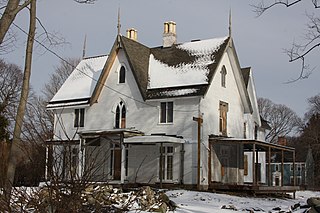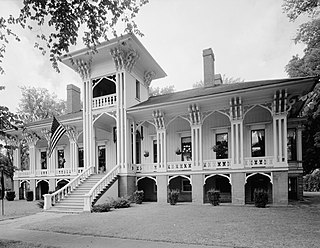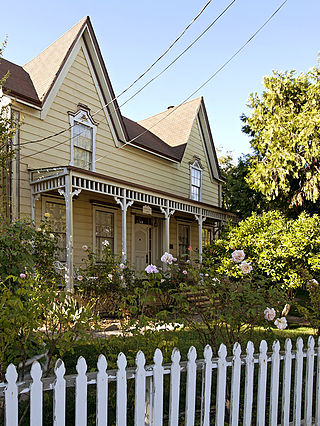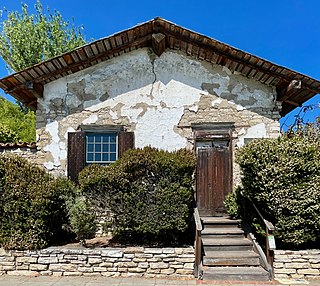
Eadweard Muybridge was an English photographer known for his pioneering work in photographic studies of motion, and early work in motion-picture projection.
The architecture of the United States demonstrates a broad variety of architectural styles and built forms over the country's history of over two centuries of independence and former Spanish, French, Dutch and British rule.

The First Unitarian Church of Oakland is located in western Downtown Oakland, California. It is a member of the Unitarian Universalist Association.

The Leland Stanford Mansion, often known simply as the Stanford Mansion, is a historic mansion and California State Park in Sacramento, California, which serves as the official reception center for the Californian government and as one of the official workplaces of the Governor of California.

Carpenter Gothic, also sometimes called Carpenter's Gothic or Rural Gothic, is a North American architectural style-designation for an application of Gothic Revival architectural detailing and picturesque massing applied to wooden structures built by house-carpenters. The abundance of North American timber and the carpenter-built vernacular architectures based upon it made a picturesque improvisation upon Gothic a natural evolution. Carpenter Gothic improvises upon features that were carved in stone in authentic Gothic architecture, whether original or in more scholarly revival styles; however, in the absence of the restraining influence of genuine Gothic structures, the style was freed to improvise and emphasize charm and quaintness rather than fidelity to received models. The genre received its impetus from the publication by Alexander Jackson Davis of Rural Residences and from detailed plans and elevations in publications by Andrew Jackson Downing.

The California School for the Blind is a public educational institution for blind children, K-12, located in Fremont, California. Its campus is located next to the California School for the Deaf.

Longfield is an historic house at 1200 Hope Street in Bristol, Rhode Island.

Mosswood Park is a 4-acre (16,000 m2) public park in Oakland, California, located on W MacArthur Boulevard between Webster Street and Broadway. Managed by the City of Oakland's Department of Parks and Recreation, it contains a community recreation center as well as extensive grassy lawns, picnic areas, children's play equipment, dog runs, tennis and basketball courts, and baseball fields.

The Larkin House is a historic house at 464 Calle Principal in Monterey, California. Built in 1835 by Thomas O. Larkin, it is claimed to be the first two-story house in all of California, with a design combining Spanish Colonial building methods with New England architectural features to create the popular Monterey Colonial style of architecture. The Larkin House is both a National and a California Historical Landmark, and is a featured property of Monterey State Historic Park.

Queen Anne style architecture was one of a number of popular Victorian architectural styles that emerged in the United States during the period from roughly 1880 to 1910. Popular there during this time, it followed the Second Empire and Stick styles and preceded the Richardsonian Romanesque and Shingle styles. Sub-movements of Queen Anne include the Eastlake movement.

Panoramic Hill is a residential neighborhood of the cities of Berkeley and Oakland, California defined by the homes along and within the access corridor defined by Panoramic Way.

The Davenport House, also known as Sans-Souci, is an 1859 residence in New Rochelle, New York, designed by architect Alexander Jackson Davis in the Gothic Revival style. The "architecturally significant cottage and its compatible architect-designed additions represent a rare assemblage of mid-19th through early 20th century American residential design". The house was listed on the National Register of Historic Places in 1980.

Kingston Museum is an accredited museum in Kingston upon Thames, southwest London, England. The Scottish-American philanthropist Andrew Carnegie funded the building of the museum, which adjoins Kingston Library.

The Jonesborough Historic District is a historic district in Jonesborough, Tennessee, that was listed on the National Register of Historic Places as Jonesboro Historic District in 1969.
Moss House or Moss Hall or variations may refer to:

Honolulu House, also known as the Abner Pratt House, is a historic home in Marshall, Michigan, built in 1860 as a Hawaiian-inspired house with Italianate and Gothic Revival styles.

West-Harris House, also known as Ambassador House, is a historic home located at 106th Street and Eller Road in Fishers, Hamilton County, Indiana, United States. The ell-shaped, two-story, Colonial Revival-style dwelling with a large attic and a central chimney also features a full-width, hip-roofed front porch and large Palladian windows on the gable ends of the home. It also includes portions of the original log cabin dating from ca. 1826, which was later enlarged and remodeled. In 1996 the home was moved to protect it from demolition about 3 miles (4.8 km) from its original site to its present-day location at Heritage Park at White River in Fishers. The former residence was listed on the National Register of Historic Places in 1999 and is operated as a local history museum, community events center, and private rental facility.

Palo Alto Stock Farm Horse Barn, also known as Stanford Red Barn or Stanford Stables, is located at present-day address 100 Electioneer Road in Stanford, California. This barn was established c.1878-1880 and is an example of Victorian-era Stick-Eastlake style architecture, though the architect is unknown. Palo Alto Stock Farm Horse Barn has been listed on the National Register of Historic Places since 1985. There are only two original buildings left from the Palo Alto Stock Farm: the red barn and the brick stable.

The Marentis House, at 45 Monterey Street in San Juan Bautista, California, was built in 1873. It was listed on the National Register of Historic Places in 1984.

Sherman Quarters, also known as Sherman Rose House is a historic adobe stone building located at 510 Calle Principal in Monterey, California. It was built by Thomas O. Larkin in 1834. It was the quarters for Lieutenant William Tecumseh Sherman in 1847. This building played a role in the U.S. military occupation of California after its seizure from Mexico during the Mexican–American War.




























